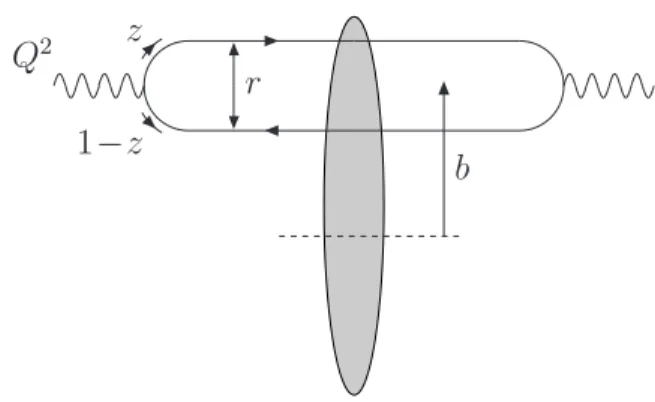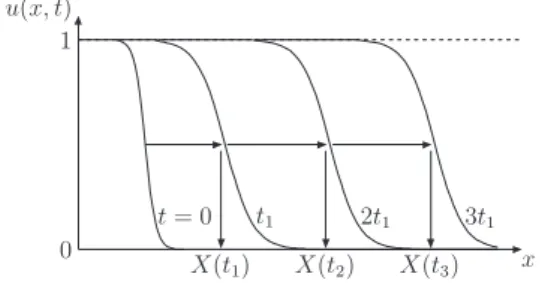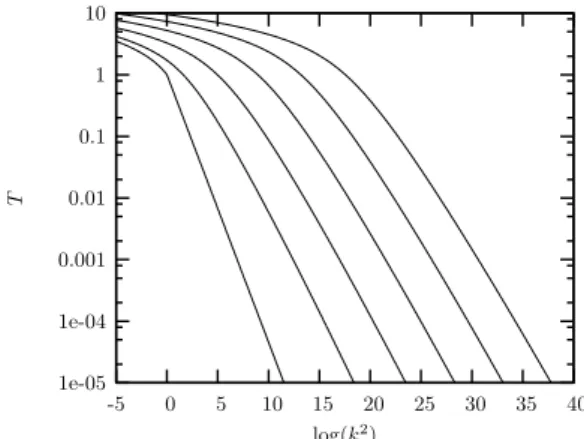648 Brazilian Journal of Physics, vol. 37, no. 2B, June, 2007
BK Equation and Traveling Wave Solutions
J. T. de Santana Amaral1, M. A. Betemps1, M. B. Gay Ducati1, and G. Soyez2∗
1Instituto de F´ısica, Universidade Federal do Rio Grande do Sul, 91501 Porto Alegre (RS), Brazil 2Service de Physique Theorique de Saclay, CEA/DSM/SPhT, F-91191 Gif-sur-Yvette, France
Received on 1st December, 2006
It has been shown that the transition to the saturation regime of high energy QCD is similar to the formation of the front of a traveling wave. In particular, it can be verified that Balitsky-Kovchegov (BK) evolution equa-tion reduces, after some approximaequa-tions, to the nonlinear Fisher and Kolmogorov-Petrovsky-Piscounov (FKPP) equation, well-known from statistical physics. In these proceedings, based on the current knowledge of the asymptotic solutions of the BK equation, we propose a parametrization for the forward scattering amplitude which interpolates between the traveling wave solution and the saturation region.
Keywords: Traveling waves; Transition to saturation
I. INTRODUCTION
Solving the problem of the growth of the cross sections for hadronic interactions with energy is still an important chal-lenge in Quantum Chromodynamics (QCD). As well-known, the increase of energy causes a fast growth of the gluon dsity and consequently of the cross sections. At very high en-ergies, it is expected that, at some point, gluon recombination and multiple scattering might be important and unitarity can be restored. This phenomenon is called saturation and has been deeply investigated over the last thirty years [1–6].
From the theoretical side, the main contribution to describe and understand the saturation in high energy QCD comes from the development of non-linear QCD equations describing the evolution of scattering amplitudes towards this limit. The sim-plest of such equations is the Balitsky-Kovchegov (BK) equa-tion [7, 8], which corresponds to the Balitsky-Fadin-Kuraev-Lipatov (BFKL) [9] linear evolution equation with the ad-dition of a non-linear term responsible for the tame of the growth of gluon density.
From the phenomenological side one has the discovery of geometric scaling in deep inelastic scattering (DIS) at HERA [10]. This phenomenological feature of high energy DIS is expressed as a scaling property of the virtual photon-proton cross section
σγ∗−p(Y,Q) =σγ∗p µ
Q2 Q2
s(Y) ¶
, (1)
that is, the cross section depends on the scaling variableτ= Q2/Q2
s(Y)instead ofQ2andQ2s(Y)separately. HereQis the virtuality of the photon,Y is the total rapidity(Y =log(1/x)) and Qs(Y) is an increasing function ofY called saturation scale. Indeed, geometric scaling has a natural explanation [11] in terms of traveling wave solutions of the BK equation.
In these proceedings we use the dipole model [12] to relate theγ∗pcross section to the dipole-proton forward scattering
∗On leave from the fundamental theoretical physics group of the University
of Li`ege
amplitude through a parametrization for the latter in momen-tum space. In Section II we relateσγ∗pto the dipole-proton scattering amplitude through the dipole framework. In Sec-tion III we introduce the BK equaSec-tion which describes the di-pole scattering amplitude and the properties of its solutions, and from these we build the parametrization for the amplitude in Section IV. In Section V we present the conclusions and discuss the applications of our model.
II. MUELLER’S DIPOLE PICTURE
Q
2z
1
−
z
b
r
FIG. 1: Picture of the dipole model.
Let us consider the collision between a virtual photon and a proton at high energy. In a frame where the photon travels fast, but most of the energy is still carried by the proton, one can consider that the photon fluctuates into aqq¯(quark-antiquark) pair, a colorless dipole, which then interacts with the proton [12]. In the leading logarithmic approximation (LLA) of per-turbative QCD (pQCD), the cross section factorizes and one gets the well-known formula
σγ∗p(Y,Q) =
Z ∞
0 r dr
Z 1
0
J. T. de Santana Amaral et al. 649
is the dipole-proton cross section. Assuming an independence on the impact parameter of the collision, this cross section is proportional to the proton-dipole forward scattering ampli-tude,T(r,Y), through the relation
σγdip∗p(r,Y) =2πR2pT(r,Y), whereR2
p is the proton radius. As we shall see in the next section, the amplitudeT(r,Y)obeys the BK equation in coor-dinate space but the asymptotic behaviour of its solutions is naturally expressed in momentum space. We want to express σγ∗pin terms of ˜T(k,Y), the Fourier transform ofT(r,Y):
T(k,Y) = 1 2π
Z d2r
r2 e
ik.rT(r,Y) =Z ∞ 0
dr
r J0(kr)T(r,Y). (3)
III. SCATTERING AMPLITUDES AT HIGH-ENERGY
Consider now a fast-moving colorless qq¯dipole of trans-verse sizer=|x−y|, wherex andyare the coordinates of the quark and antiquark, respectively, interacting with a given dense target. In the large-Nc approximation (Nc is the num-ber of colors), and in the mean-field approximation, the high-energy behaviour of the dipole forward scattering amplitude T(x,y;Y)follows the BK equation [7, 8]. In coordinate space this equation reads
∂YT(x,y;Y) = α¯ 2π
Z
d2z (x−y)
2
(x−z)2(z−y)2
[T(x,z;Y) +T(z,y;Y)−T(x,y;Y)−T(x,z;Y)T(z,y;Y)] (4) which, as it was said in the Introduction, corresponds to the BFKL equation (the first three terms inside the brackets), but with an additional term (the term quadratic inT) which by its turn corresponds to the nonlinear effects responsible for the decreasing of the growth in the gluon density. Here
¯
α=αsNc/π,αs is the strong coupling constant (considered fixed). If one neglects the dependence on the impact para-meterb= (x+y)/2 and integrates out the remaining angular dependence ofr, Eq.(4) becomes an equation forT(r,Y). The latter can be expressed in momentum space through (3).
The amplitude ˜T(k,Y)obeys the BK equation in momen-tum space
∂YT˜=αχ(¯ −∂L)T˜−α¯T˜2, α¯=αsNc
π , (5)
whereαsis the strong coupling constant,Ncis the number of colours,
χ(γ) =2ψ(1)−ψ(γ)−ψ(1−γ) (6)
is the characteristic function of the Balitsky-Fadin-Kuraev-Lipatov (BFKL) kernel [9] and
L=log µ
k2 k20
¶ ,
wherek0is some fixed low momentum scale. The kernelχ(γ) is an integro-differential operator which may be defined with the help of the formal series expansion
χ(−∂L) =χ(γ0)1+χ′(γ0)(−∂L−γ01) +1
2χ ′′(γ
0)(−∂L−γ01)2+ 1 6χ
(3)(γ
0)(−∂L−γ01)3+. . .
(7) for someγ0between 0 and 1, i.e. for the principal branch of the functionχ.
A. Traveling wave solutions
If one performs the following change of variables
t∼α¯Y, x∼log(k2/k20), u(x,t)∼T˜(k,Y) (8) it has been shown [11] that the BK equation reduces to the Fisher and Kolmogorov-Petrovsky-Piscounov (F-KPP) equa-tion [13] foruwhen its kernel (6) is approximated by the first three terms of the expansion, the so-calleddiffusive approx-imation. The F-KPP equation is a well-known equation in non-equilibrium statistical physics, whose dynamics is called reaction-diffusion dynamics, and it has the form
∂tu(x,t) =∂2xu(x,t) +u−u2, (9) wheretis time andxis the coordinate. This equation admits the so-called traveling wave solutions.
t= 0 t1
X(t1)
2t1
X(t2)
3t1
X(t3) x
0 1 u(x, t)
FIG. 2: Traveling wave behaviour foru(x,t), solution of Eq.(9).
For a traveling wave solution one can define the position of a wave frontx(t) =v(t), irrespective of the details of the non-linear effects. At larger times, the shape of a traveling wave is preserved during its propagation, and the solution becomes only a function of the scaling variablex−vct, wherevcis the critical velocity.
In the language of saturation physics the position of the wave front is nothing but the saturation scale
x(t)∼lnQ2s(Y) (10) and the scaling cited above corresponds to the geometric scal-ing
650 Brazilian Journal of Physics, vol. 37, no. 2B, June, 2007
The linear part of (5) is solved by [11] ˜
T(k,Y) =
Z dγ
2πiT˜0(γ)exp(−γL+αχ(γ)¯ Y), (12) where ˜T0(γ)is the Mellin transform of the initial condition at Y =0. The velocity of the front is given by
vc=min
γ α¯
χ(γ) γ =α¯
χ(γc)
γc =αχ¯ ′(γc) (13)
whereγcis the saddle point of the exponential phase factor. This fixes, for the BFKL kernel, γc=0.6275...,and vc= 4.88 ¯α.
log(k2)
T 40 35 30 25 20 15 10 5 0 -5 10 1 0.1 0.01 0.001 1e-04 1e-05
FIG. 3: Numerical solution to BK equation for increasing (from left to right) values of rapidityY=0,5,10,15,20,25. The traveling wave behaviour with increasing rapidity is clearly manifest.
In terms of QCD variables, the dipole forward scattering amplitude in momentum space in the tail of the wave front reads
˜
T(k,Y)k≫≈Qs µ
k2 Q2
s(Y)
¶−γc
log
µ
k2 Q2
s(Y) ¶
exp
"
−log
2¡
k2/Q2 s(Y)
¢
2 ¯αχ′′(γc)Y #
.
(14) The saturation scale is defined as
Q2s(Y) =k02exp Ã
¯ αvcY−
3
2γclog(Y)− 3 γ2 c s 2π ¯ αχ′′(γc)
1 √ Y ! . (15)
IV. CONNECTION WITH SATURATION
The goal of this work is to describe the matching around the saturation scale between two regions: the one described by the tail of the wave front, Eq.(14) and the other one, characterized by saturation. The latter can be parametrized as
˜
T(k,Y)k≪≈Qsc−log
µ k
Qs(Y) ¶
, (16)
wherecis an arbitrary constant.
0 1 2 3 4 5
k/Qs 0 2 4 6 8 10 T(k,Y) [Y=1]
FIG. 4: Matching procedure between the tail of the wave front (solid line) and the saturation region (dashed line) through the continuity of
˜
T(k,Y)and its first derivative forY =1.
Given that the fully asymptotic behaviour of the amplitude is described by (14) and (16), our first attempt to connect both was to use both behaviours separately and match the constant cfrom continuity conditions (see Figure 4).
However, such matching procedure does not necessarily imply a positive Fourier transform of the scattering amplitude. Then, the best way to obtain the description of such transition to the saturation region is to make an analytic interpolation procedure. The idea is to build the saturation domain from the dilute one and the starting point is a function, that we call ˜Tdil, which reproduces (up to the logarithmic factor) the amplitude for diffusive scaling (14),
˜
Tdil=Aexp "
−γclog µ k2
Q2 s(Y)
¶ −L
2
red−log2(2) 2 ¯αχ′′(γc)Y
# (17)
with
Lred=log ·
1+ k 2
Q2 s(Y)
¸
(18)
and write ˜T in terms of it in such a way that we can recover the asymptotic behaviours of ˜T,i.e., Eqs. (14) and (16).
One expression which satisfies these properties is the fol-lowing:
˜
T(k,Y) = LF 1+T˜1dil
, (19)
where the logarithmic factor
LF= s
K2+1 4log
2 k2 Q2
s(Y)
(20)
J. T. de Santana Amaral et al. 651
V. CONCLUSIONS
In this work we have investigated the matching between saturation and travelling wave solutions of the BK equation which describe the forward scattering amplitude at high en-ergies in the virtual photon-proton scattering. As the result does not necessarily imply a positive Fourier transform of the amplitude, we concluded that the best way to connect both solutions is through an analytic interpolation model. An ex-pression for the amplitude, Eqs.(17)–(20), has been proposed
and tested in order to be used to describe some experimental data. This work is in progress.
Acknowledgements
This work is partially supported by CNPq, Brazil. G.S. is funded by the National Funds for Scientific Research (FNRS, Belgium).
[1] L. V. Gribov, E. M. Levin, and M. G. Ryskin, Phys. Rep.100, 1 (1983).
[2] A. H. Mueller and J. Qiu, Nucl. Phys. B268, 427 (1986). [3] A. H. Mueller, Nucl. Phys. B335, 115 (1990).
[4] J. Jalilian-Marian, A. Kovner, A. Leonidov, and H. Weigert, Nucl. Phys. B 504, 415 (1997) [arXiv:hep-ph/9701284]; E. Iancu, A. Leonidov, and L. D. McLerran, Nucl. Phys. A692, 583 (2001) [arXiv:hep-ph/0011241]; H. Weigert, Nucl. Phys. A
703, 823 (2002) [arXiv:hep-ph/0004044].
[5] A. L. Ayala, M. B. Gay Ducati, and E. M. Levin, Nucl. Phys. B
493, 305 (1997); Nucl. Phys. B551, 335 (1998).
[6] Yu. V. Kovchegov and A. H. Mueller, Nucl. Phys. B529, 451 (1998).
[7] I. I. Balitsky, Nucl. Phys. B463, 99 (1996); Phys. Rev. Lett.
81, 2024 (1998); Phys. Lett. B518, 235 (2001); arXiv:hep-ph/0101042.
[8] Y. V. Kovchegov, Phys. Rev. D60, 034008 (1999);61, 074018
(2000).
[9] L. N. Lipatov, Sov. J. Nucl. Phys.23, 338 (1976); E. A. Kuraev, L. N. Lipatov, and V. S. Fadin, Sov. Phys. JETP45, 199 (1977); I. I. Balitsky and L. N. Lipatov, Sov. J. Nucl. Phys. 28, 822 (1978).
[10] A. M. Stasto, K. Golec-Bernat, and J. Kwiecinski, Phys. Rev. Lett.86, 596 (2001).
[11] S. Munier and R. Peschanski, Phys. Rev. Lett. 91, 232001 (2003); Phys. Rev. D 69, 034008 (2004); Phys. Rev. D70, 077503 (2004).
[12] A. H. Mueller, Nucl. Phys. B415, 373 (1994); A. H. Mueller and B. Patel, Nucl. Phys. B425, 471 (1994); A. H. Mueller, Nucl. Phys. B437, 107 (1995).


